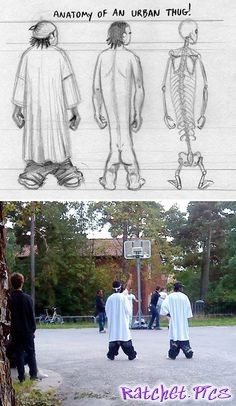In a visual exploration of urban attire, this image juxtaposes two distinct perspectives: a satirical illustration versus a snapshot of reality. The upper portion of the image presents a hand-drawn depiction titled “Anatomy of an Urban Thug,” which suggests a prejudiced viewpoint. The sketch, reminiscent of biological diagrams, breaks down the attire commonly associated with urban youth culture, including oversized clothing and sagging pants. This artistic interpretation alludes to a skeletal structure, seemingly criticizing the style as an extension of the individual’s identity.
The caricature appears to imply a negative stereotype, potentially echoing societal judgments and misconceptions about individuals who choose this fashion. The oversized garments are exaggerated to an impractical extent, and the drawing insinuates a form of dehumanization by reducing a person to a mere anatomical study, labeled with a pejorative term. The artist’s choice to emphasize certain features seems to mock the aesthetic preferences of the depicted individuals, possibly suggesting a larger narrative about societal alienation and the branding of subcultures.
Below the illustration, the reality presents itself quite differently. The photograph captures two individuals dressed in a style similar to that of the illustration. Yet, in their real-world setting—a basketball court surrounded by trees and an everyday environment—their attire seems far less caricatured. The photograph does not exaggerate their clothes’ fit or style; instead, it shows a common, casual fashion choice among many young people, particularly in urban settings. Their sagging pants and large shirts are typical of the cultural trend known as “streetwear,” often adopted by youths as a statement of identity and belonging within their communities.
This comparison subtly invites the observer to reflect on the contrast between exaggerated perceptions and lived reality. It highlights how artistic expression can sometimes perpetuate stereotypes, while everyday moments captured through photography can offer a more authentic glimpse into the lives and choices of individuals. In doing so, it underscores the importance of separating exaggerated depictions from the genuine human experience, reminding us of the complexity and nuance that lies behind the labels society may too quickly assign.
